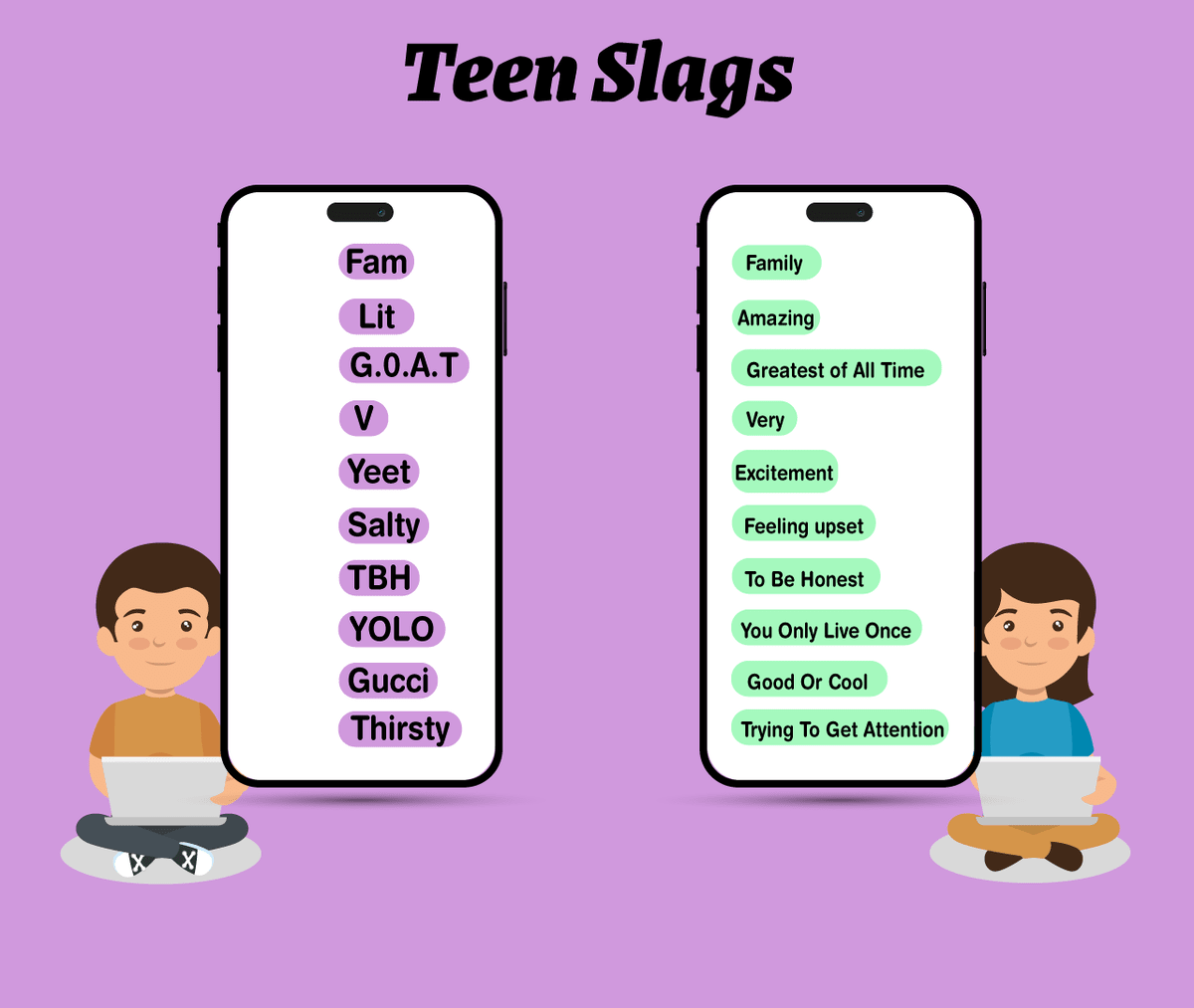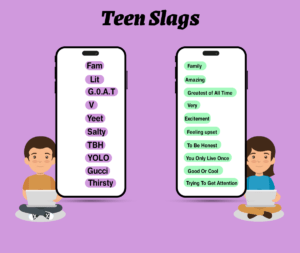Master the lingo children use on TikTok, in texts, and more
Every generation’s youth acquires a distinct language. Parents have grown up hearing phrases like “outta sight” and “phat,” which have evolved into more specific terms like “sick” and “gag me with a spoon,” which may even become “vintage” themselves. Though they are a part of the young culture (and the terminology that defines it), as you get older, at least until you become a parent, it can get harder and harder to stay up to date on the newest language.
Slang Words Overview
The growth of social media, memes, digital communication, and the widespread cellphone has made it more difficult to understand teenagers’ language. The language of teenagers is changing more quickly than ever. It’s conceivable that you’re falling behind again just when you think you’ve mastered a few expressions. Certain slang terms become commonplace, but at that point, they lose their coolness—or, as the youth say, “sic.” But most of these terminology just disappear when they become less common among the younger generation, quickly being replaced by other terms.
Therefore, even though we grownups think we’re “with it” and modern, the majority of us would benefit from a crash course in the newest lingo used by teenagers. From figuring out text message shortcuts and social media acronyms to knowing the language for pals, drugs, and social events, we’ve got you covered here.
It is important to become familiar with common teenage lingo so that you can understand what your adolescent is talking about, whether they are on the phone or in person.
General:
Teens use many words that may appear foreign to people who don’t know them, but most are harmless and a natural element of being a teenager. Teens connect with their peers and utilize these terms as a means of freedom and coolness. They feel different, want to make a name for themselves, and are even a little rebellious. You can learn the following common teenage slang words:
1. AF – is a contraction for “as f**k,” and it’s used to highlight certain points (like “she’s cool AF”).
2. Cheugy – A term used to describe something out of date or someone who is overly fashion conscious.
3. Dead – Used to describe something that makes you “die” of laughing because it’s so funny.
4. Dope: A word used to describe something cool or fantastic.
5. Extra – Characterizes anything as extreme, exaggerated, or over the top.
6. Fit: A shortened form of “outfit.”
7. Fire: (Originally “straight fire”) Used to convey the idea that something is hot, fashionable, outstanding, or spot-on.
8. GOAT – An acronym for “Greatest of All Time.”
9. Go Off: This expression encourages someone to go on, usually during an intense discussion (though it can also be used sarcastically, like “but go off, I guess”).
10. Gucci: A slang expression for something excellent, hip, or doing well.
11. Hits Different: A term used for something that is noticeably superior to the norm.
12. IYKYK – An acronym meaning “if you know, you know,” usually applied to information that is known to a small number of people.
13. Lit: A term expressing something noteworthy, amazing, or cool.
14. Low-Key – Used to minimize an emotion or desire (i.e. “I’m low-key freaking out”).
15. Mood: A word for when you agree with someone.
16. OMG: A contraction of “Oh my gosh” or “Oh my God,” which conveys surprised or excitement.
17. ONG – Like “I swear to God,” this expression emphasizes sincerity.
18. Salty: This word expresses resentment, fury, or agitation.
19. Sic/Sick: Described something as amazing, adorable, or cool.
20. Slay: To be extraordinarily fashionable or successful.
21. Sleep On: The act of disregarding or underestimating someone or something (e.g., “Don’t sleep on the new Ariana single”).
22. Snatched: A slang phrase meaning being stylish, flawless, or well-groomed; the modern form of “on fleek.”
23. TBH: An acronym meaning “to be honest.”
24. Tea – Refers to rumors, events, tales, or news.
25. Thirsty: Describes a person who is attention-seeking.
26. Yassify: The process of heavily editing a photo to make a person not identifiable.
27. Yeet: To throw anything forcefully.
28. YOLO – An acronym for “You Only Live Once,” which is typically used to defend taking chances or making bold decisions.
Teen Parties, Drugs, and Sex
Adolescents frequently experiment with limits, participate in dangerous activities, and use slang to express their feelings. Although a lot of this slang is used playfully or arrogantly, it may also refer to activities that could be risky.
Teen gatherings and parties are typically a normal part of adolescence, but they can lead to concerns about supervision, appropriate conduct, substance use, alcohol, peer pressure, bullying, and unprotected sexual activity. It’s important to know your child’s vernacular and be aware of terms that could indicate problems, regardless of whether they engage in any inappropriate or dangerous actions.
The following is a collection of social slang terms that kids use that you should know:
1. 53X: Sex (A secretly suggestive allusion to intimate activity).
2. Body count: Indicates how many individuals a person has shared intimate relations with.
3. CU46: This acronym stands for “See you for Sex.”
4. Function/Func: A social event or celebration.
5. Kick back: A casual, simple gathering.
6. Molly: A mention of the potentially harmful party drug ecstasy (MDMA).
7. Netflix and chill: A colloquial expression that’s frequently used as an excuse to ask someone over for a private gathering.
8. Plug: Someone having drug-dealing connections
9. Rager: A sizable and wild party.
10. Smash: To have a playful sexual activity.
11. Sloshed: To be very intoxicated or drunk.
12. The plug: A provider of drugs or alcohol.
13. Throw down: To throw or conduct a party.
14. Turnt: (formerly known as “turnt up”): To be drunk or stoned.
15. X: Ecstasy.
16. WTTP: Want to trade photos?
17. LMIRL: Let’s meet in real life
18. Dayger: A daytime party.
Understanding People and Relationships
The teenage years are crucial for creating and establishing relationships. Adolescents set out on an adventure of self-discovery in an attempt to understand who they are outside of their familial duties. Throughout this trip, their connections with peers are crucial, and as a result, they frequently create unique terminology to characterize their love relationships and friendships.
The following are some common phrases that your adolescent may use to describe other people:
1. Bae: This term, which means “before anyone else,” is used to refer to a close friend or romantic relationship.
2. Basic: Denotes something uninteresting, commonplace, or unoriginal.
3. BF/GF: Shorthand for “boyfriend” or “girlfriend,” primarily used in text messaging.
4. BFF: This acronym denotes “best friends forever.”
5. Bruh: A common phrase that is gender-neutral and similar to “bro” or “dude.”
6. Cap: Indicates something untrue or wrong.
7. CEO: Being the “CEO of” something denotes mastery in that area.
8. Curve: To reject someone romantically; frequently associated with “ghosting.”
9. Emo: A person who is dramatic or emotional is referred to as such.
10. Fam: is the collective term for a very close friendship group.
11. Flex: Denotes bragging.
12. Ghosted: Breaking a relationship unexpectedly without any explanation.
13. A Karen: A term used to describe a person, often a middle-aged woman, who acts rudely or complains, particularly towards service industry workers. For instance, you might say, “She’s acting like a Karen,” when someone returns their drink at a restaurant for not having enough ice.
14. No cap: A statement that indicates something is 100% truthful or not a falsehood.
15. Noob/n00b: identifies a person who is essentially a newbie and lacks experience or expertise in a particular area.
16. OK, Boomer: Usually used in reaction to out-of-date notions or individuals from a previous generation.
17. Period: A forceful method to wrap up a sentence. As an example, “That’s the best ice cream, period.”
18. Ship: The term “ship” refers to supporting or picturing two people as a pair; it is essentially an adaptation of the word “relationship.”
19. Shook: Used to convey extreme shock or being profoundly impacted by something.
20. Simp: A person who exhibits intense attraction to someone and goes to considerable measures for them is referred to as a simp.
21. Spill the Tea: Requesting a juicy gossip from someone.
22. Squad: A group of buddies who hang together regularly; frequently used in a satirical way.
23. Stan: An eager and passionate follower of a particular band or star.
24. Sus: denotes that something or someone is dubious, dishonest, and untrustworthy.
25. Throw shade: giving a disapproving or criticizing glance at someone.
26. Tight: Defines having a close bond or relationship with someone.
27. Tool: A phrase for someone who is viewed as stupid, annoying, disrespectful, and frequently embarrassing, commonly associated with a stereotypical jock personality.
Combination Teen Slang
Teens often combine two words to create short phrases. You must understand the meaning of each word separately to understand them. Here are a few examples of mixed-teen slang:
1. Crashy: A combination of the words “crazy” and “trashy,” signifying something disorganized and poor, similar to a train accident.
2. Crunk: A combination of the words “crazy” and “drunk,” which describes a situation in which one is extremely wild and drunk as well as high.
3. Hangry: Combines the words “hungry” and “angry,” characterizing the unsettled state brought on by hunger.
4. Requestion: A fusion of the words “request” and “question,” signifying either to pose a question again or to request something through questioning.
5. Tope: Combines the terms “tight” with “dope,” denoting something exceptional and cool.
Encouraging Open Dialogue About Slang with Your Teen
To help you understand any foreign lingo, you might also think about getting in touch with your adolescent or other familiar teenagers. Even though it might feel a little strange at first, talking to your adolescent about these terminologies can open up an important conversation with them.
A Word From V Lovemami
Strive to find a balance between protecting your adolescent and honoring their freedom and privacy. Have frank discussions with your adolescent to resolve any issues, set ground rules for the family, and encourage social media usage that is appropriate and safe.
Teens should be allowed to conduct private conversations with their friends, and it is not practical nor desirable to constantly watch over your teen’s internet activity. But, it’s crucial to keep an eye on your adolescent’s social media interactions and pay close attention to them when they interact with their peers. If you encounter conversations that raise concerns or are difficult to understand, be prepared to take appropriate action.















